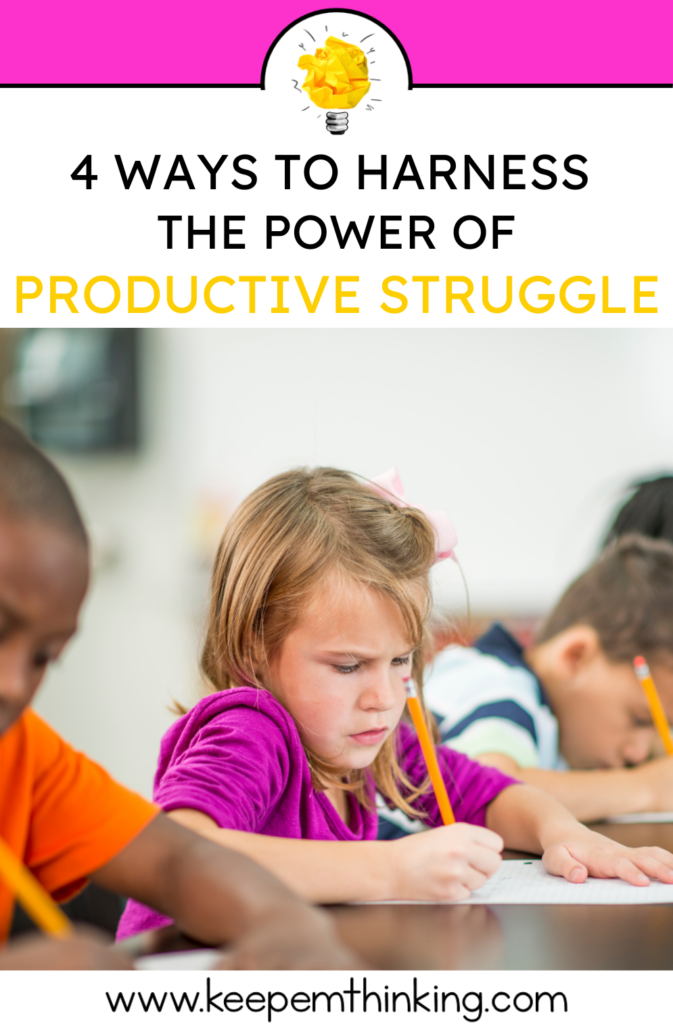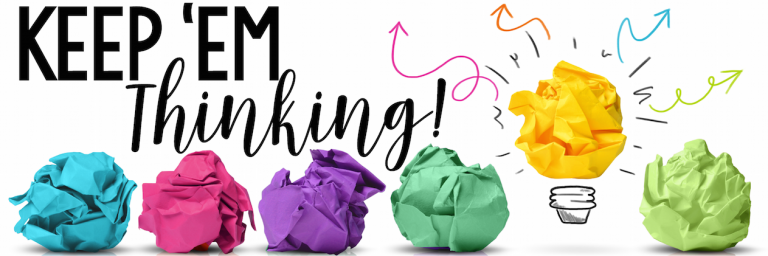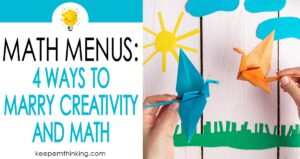Have you ever thought about the fact that the skills that are the hardest for you to learn are often the ones you remember best? That is not a coincidence. That’s a result of productive struggle. As teachers, this is what we should want for our students. Not to challenge them to frustration but to provide opportunities where they are challenged and taught how to work through that learning struggle in a productive way. Here are four ways you can build productive struggle into your lessons and classroom.
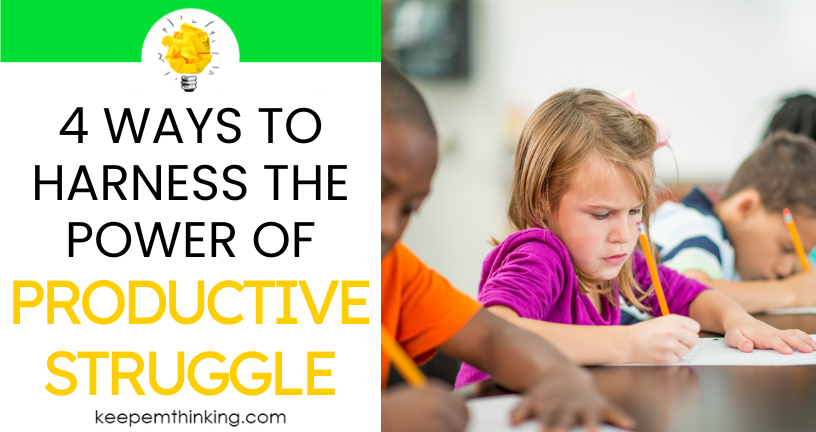
What is Productive Struggle?
Productive struggle is when students engage with new information on a deeper level. It’s learning that goes beyond just completing an assignment on a skill you already know or rote memorization. Productive struggle engages the brain in ways that lower level learning doesn’t. This article from edutopia is a great one if you want to learn more about the neuroscience behind productive struggle.
Productive struggle is an important part of the learning process. Some of our students never have to struggle with skills or concepts – they just get it. But when they just get it, they aren’t being challenged in the learning process. They don’t have to develop or use higher level thinking skills, they don’t learn how to push through low level frustration and they don’t get the benefits of engaging with new skills and concepts in a challenging way. Building in productive struggle is a way that we can teach our students to dig deeper, ask better questions, and utilize new problem-solving strategies. Let’s look at 4 ways to harness the power of productive struggle in your classroom.
1. Use group work.
When students work collaboratively, they can share ideas and solutions. Before you group your students, remember the following tips:
- Don’t put high-achieving students in groups to serve as leaders or tutors. It’s often our high-achieving students that are the ones missing out on productive struggle!
- Communicate clear expectations to your students. They need to know exactly what is expected.
- Stress the importance of a supportive classroom culture.
- Make sure that everyone in the group is responsible for contributing their thoughts.

When you give tasks that require a deeper level of thinking, students may get frustrated. Group work will help students overcome these frustrations. They can ask their peers for ideas if theirs don’t work the first time. Students can encourage each other, as well as offer different ideas and viewpoints towards problem-solving.
Group work requires everyone to communicate, which is key when using productive struggle in your classroom. Students must talk through tasks, helping others see new ways of completing tasks.
When students work in groups, they are also learning social-emotional skills. Students need to learn to work together, which includes being comfortable around new groups of people, learning how to communicate their ideas to others, and learning to be attentive listeners.
2. Give students more time.
I’ve seen countless math worksheets with too many problems to solve. If a student understands it, why should they have to do more work? And . . . if a student doesn’t understand it they likely won’t finish all the problems.

Instead, I would like to challenge you to give students fewer problems to solve, and more time to solve them. If they make mistakes it is ok! With extra time they can find those mistakes and think through how to fix them. This my friends is the learning process!
When you provide students with a rigorous math problem, they need time to explore the task at hand.
Give your students time to process, think, and try different solutions. Provide opportunities for them to collaborate and justify their reasoning.
This will benefit students because they will retain the information they learned on a much deeper level.
3. Encourage a Growth Mindset.
When you use productive struggle in your classroom, your students will struggle – at first. Learning to recognize and push through frustration is not a skill that comes naturally. That’s why it is so important to teach your students to think with a growth mindset.
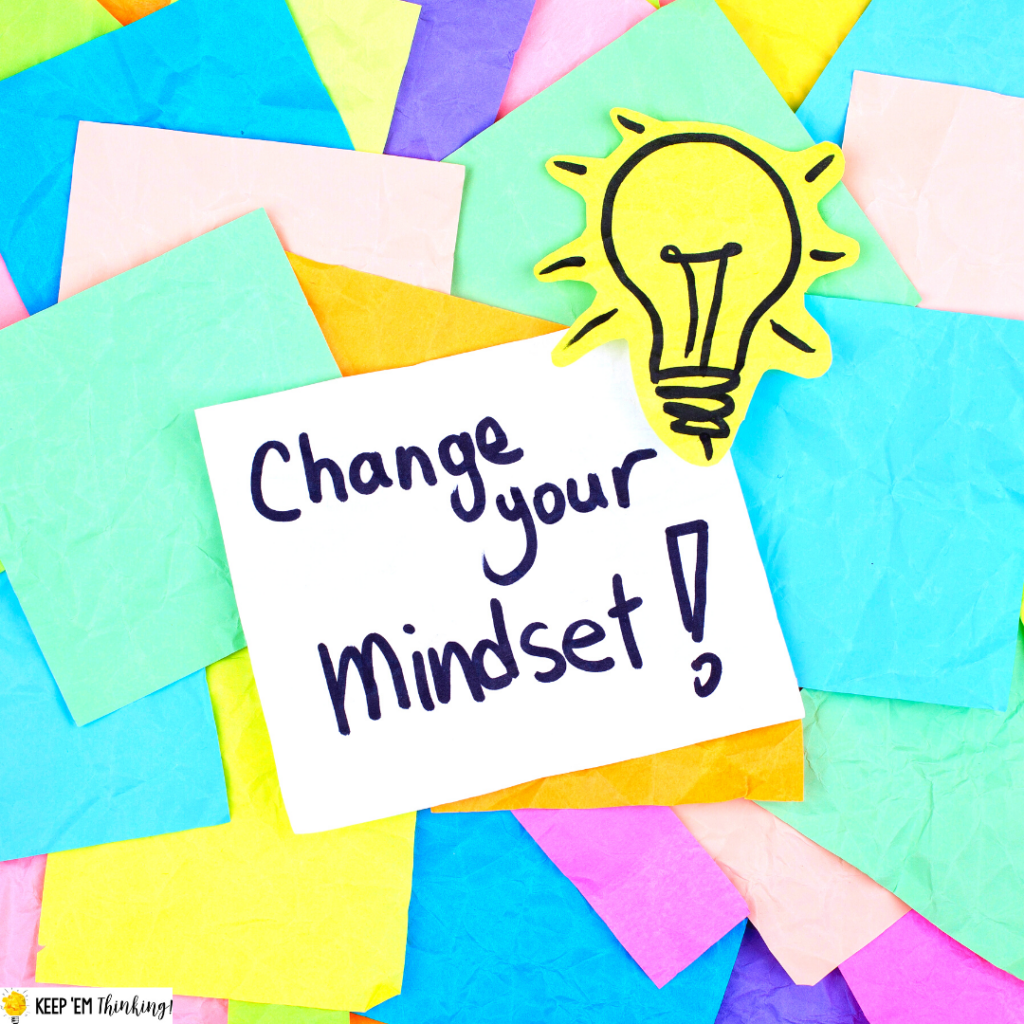
“In a growth mindset, people believe that their most basic abilities can be developed through dedication and hard work – brains and talent are just the starting point. This view creates a love of learning and a resilience that is essential for great accomplishment.” (Dweck, C. 2015)
Picture that student who gets a challenging problem, and just can’t solve it. This student can give up and feel bad. Or, if you’ve instilled a growth mindset in your students, this student can keep trying until the problem is solved. This student may say, “I can’t solve this… YET, but I will.” And when they do, their self-confidence has soared and they are more likely to remember how to solve that type of problem again.
Here are some growth mindset statements that you can use in your classroom to support productive struggle:
- When you learn how to do a new kind of problem, it develops your brain.
- Your goal isn’t to get it right immediately. Your goal is to improve your understanding. What can you try next?
- With more practice, this will get easier!
- How can you learn from that mistake?
- What can you do differently next time?
- Mistakes are how you learn and get better!
- You’re still learning, so keep trying!
- You will get it, so never give up!
- What other strategy can you use?
- If that plan didn’t work, let’s try another plan.
4. Praise students who give a different answer or a different point of view.
So many times we praise the students who always get the right answer. We display the highest test scores on a bulletin board. We let the same students come up to the board to show their perfect calculations. What if we try something different?
You can use the power of productive struggle by praising all students. Of course, it’s ok to praise the students who get it right, but what if you consciously make an effort to praise the students who are trying?

Let’s say that you give your students a math problem to solve. Instead of asking for the answer, try asking for different strategies. Let students show their classmates the different ways they solved the problem.
Congratulate your students by saying, “Wow! I love how your brain worked to solve that!” You can also say, “I love how you figured this out! I never would have thought of that!” You can ask if others solved it in a different way, and give those students time to share their thinking.
If you praise students for thinking differently, you will make them feel differently, and that’s a good thing! Your students will start looking at problems in a new way, and you’ll see them trying lots of new ways of thinking. You are using productive struggle to transform the way your students think. You are building confidence, a strong classroom community, and students that will change the world.
Save it for Later
Be sure to pin this to your favorite classroom Pinterest board, so you’ll be able to get back to the benefits of productive struggle!
